Plus Two Botany Notes Chapter 8 Environmental Issues is part of Plus Two Botany Notes. Here we have given Plus Two Botany Notes Chapter 8 Environmental Issues.
| Board | SCERT, Kerala |
| Text Book | NCERT Based |
| Class | Plus Two |
| Subject | Botany Notes |
| Chapter | Chapter 8 |
| Chapter Name | Environmental Issues |
| Category | Plus Two Kerala |
Kerala Plus Two Botany Notes Chapter 8 Environmental Issues
Air pollution
Pollutants are harmful substances that affect growth and yield of crops and cause premature death of plants. In animals they affect the respiratory system and causes diseases.
Smokestacks of thermal power plants, smelters and other industries release particulate and gaseous air pollutants together with harmless gases, such as nitrogen, oxygen, etc.
Electrostatic precipitator:
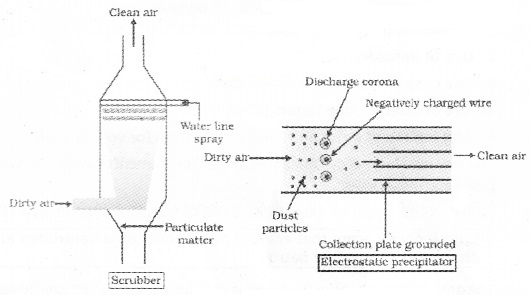
These are separated using electrostatic precipitator which can remove over 99 per cent particulate matter present in the exhaust from a thermal power plant.
At high voltage the electrons produced in an instrument are attached to dust particles giving them a net negative charge. These charged dust particles are attracted by collecting plates. Then reducing the velocity of air between the plates which help the dust to fall.
| Scrubber is an instrument that remove gases like sulphur dioxide present in the exhaust. |
| According to Central Pollution Control Board (CPCB), particulate size 2.5 micrometers or less in diameter (PM 2.5) are adversely affect the lungs followed by breathing and respiratory symptoms, irritation, inflammations and results premature death. |
Automobiles are the largest source of air pollution in big cities .It is avoided by using lead-free petrol or diesel and catalytic converters, (platinum-palladium and rhodium as the catalysts) for reducing emission of poisonous gases.
| The exhaust when passes through the catalytic converter, the unburnt hydrocarbons are converted into carbon dioxide and water, and carbon monoxide and nitric oxide are changed to carbon dioxide and nitrogen gas, respectively. |
If once fitted the catalytic converter, there must be used unleaded petrol because lead in the petrol inactivates the catalyst.
1. Controlling Vehicular Air Pollution:
A Case Study of Delhi:
Analysis showed that in 1990s, Delhi ranked fourth among the 41 most polluted cities of the world. The serious air pollution problems in Delhi was reduced after filing public interest litigation (PIL) in the Supreme Court of India. After that Delhi govt, orderd of using compressed natural gas (CNG) in public transport, i.e., buses.
| CNG is better than diesel. It bums most efficiently. CNG is cheaper than petrol or diesel and cannot be adulterated like petrol or diesel. |
The supply of CNG for major distribution centres through pipelines is difficult. In the meantime Delhi govt, is also taken parallel steps for reducing vehicular pollution that is to
Control pollution in big cities:
- Avoid the use of old vehicles
- Use of unleaded petrol
- Use of low-sulphur petrol and diesel
- Use of catalytic converters in vehicles,
- Application of strict pollution level norms for vehicles, etc.
The new auto fuel policy introduced by the Government of India is to reduce the sulphur and aromatic content in petrol and diesel fuels.
| Euro II norms aims that amount of sulphur to be controlled at 350 parts-per-rhillion (ppm) in diesel and 150 ppm in petrol. |
The goal, according to the roadmap, is to reduce sulphur to 50 ppm in petrol and diesel and bring down the level to 35 percent. For these purpose, vehicle engines should be upgraded.
The Bharat Stage II (equivalent to Euro-ll norms) is applicable to all automobiles throughout the country from April 1, 2005.
| Euro III emission specifications brought out in 11 cities from April 1, 2005and later the Euro-IV norms by April 1, 2010. |
Analysis shows that, great reduction in CO2 and SO2 level in Delhi between 1997 and 2005. In India, the Air (Prevention and Control of Pollution) Act came into force in 1981, but was amended in 1987 to include noise as an air pollutant. It causes psychological and physiological disorders in humans.
| The sound level above 150 dB arises due to the jet plane or rocket take off, damage ear drums and permanently impairing hearing ability. Noise also causes sleeplessness, increased heart beating and altered breathing pattern in humans. |
It is necessary to reduce noise by using sound absorbing materials in industries. Govt, laws are there to reduce noise pollution around hospitals and schools by avoiding the use of air – horns, restriction in the use of loudspeakers etc.
Water Pollution And Its Control
To safeguard water resources, Government of India has passed the Water (Prevention and Control of Pollution) Act, 1974. It helps to maintain the water bodies clean.
1. Domestic Sewage and Industrial Effluents:
About 0.1 per cent impurities present in domestic sewage unfit for human use. Domestic sewage mainly contains biodegradable organic matter, which is decomposed by bacteria and other micro-organisms. The amount of organic matter present in sewage can be measured by Biochemical Oxygen Demand (BOD).
For the biodegradation of organic matter by micro-organisms require plenty of oxygen, it results in sharp decline in dissolved oxygen. This causes mortality of fish and other aquatic creatures.
Presence of large amounts of nutrients in waters also causes excessive growth of planktonic(free-floating) algae, called an algal bloom which gives colour to the water bodies. Algal blooms cause lose of the water quality and fish mortality. Some are toxic to human beings and animals.
Effect of sewage discharge on some important characteristics of water:

Presence of excessive nutrients cause water hyacinth (Eichhornia crassipes), to grow in plenty, it causes blocks in our waterways. These are plants of the world’s most problematic aquatic weed called Terror of Bengal’. They grow abundantly in eutrophic water bodies, and lead to an imbalance in the ecosystem of the water body.
View of algal bloom:
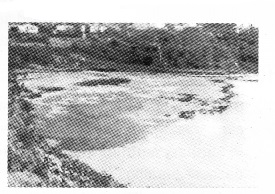
Sewage from homes and hospitals contain undesirable pathogenic microorganisms it causes outbreak of serious diseases, such as dysentery, typhoid, jaundice, cholera, etc.
Domestic sewage from industries like petroleum, paper manufacturing, metal extraction and processing, chemical manufacturing, etc. contains as mercury, cadmium, copper, lead, etc.
| Clorinated toxic hydrocarbons such as DDT, BHC etc present in industrial waste waters passes through successive trophic levels of food chain and causes accumulation. This is called Biomagnification. |
The concentration of DDT is increased at successive trophic levels, it starts at 0.003 ppm in water, it can ultimately can reach 25 ppm in fish-eating birds, through biomagnification.
High concentrations of DDT disturb calcium metabolism in birds, which causes the thinning of eggshell and their premature breaking, causing decrease in bird populations.
Eutrophication is the natural aging of a lake by nutrient enrichment of soil. It occurs when nitrates and phosphates reaches water bodies by run off water.
Biomagnification of DDT in aquatic food chain:
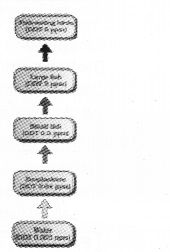
Pollutants from man’s activities like effluents from the industries and homes can accelerate the aging process. This phenomenon is called Cultural or Accelerated Eutrophication. It causes depleting oxygen content of water and results the death of fish and other aquatic organisms.
Heated (thermal) wastewaters from thermal power plants destroy the growth of aquatic organisms. But it promote the growth of aquatic organisms in cold waters.
2. A Case Study of Integrated Waste Water Treatment:
An example of such an initiative was put into practice at the town of Areata, situated along the northern coast of California. Biologists from the Humboldt State University, and the townspeople created an integrated water treatment process within a natural system.
The cleaning occurs in two stages-
| (a) The conventional sedimentation, filtering and chlorine treatments. After this stage, lots of dangerous pollutants like dissolved heavy metals are there. (b) The biologists developed a series of six connected marshes over 60 hectares of marshland. Appropriate plants, algae, fungi and bacteria were seeded into this area, which neutralise, absorb and assimilate the pollutants. Hence, as the water flows through the marshes, it gets purified naturally. The marshes of Arcta rich in biodiversity especially fishes, animals and birds. So the Friends of the Areata Marsh (FOAM) were responsible for safeguarding of this wonderful project. |
Ecological sanitation:
It is a sustainable system for handling human excreta, using dry composting toilets. This is a practical, hygienic, efficient and cost-effective solution to human waste disposal.
Here human excreta is recycled and reduces the need for chemical fertilisers. This is the basis of ‘EcoSan’ toilets in many areas of Kerala and Sri Lanka.
Solid Wastes
Solid wastes especially municipal solid wastes are wastes from homes, offices, stores, schools, hospitals, etc. contain, comprise paper, food wastes, plastics, glass, metals,rubber, leather, textile, etc. These are subjected to Sanitary landfills in which wastes are dumped in a depression after packed and covered with dirt everyday because burning is not practicable.
In metros Landfills are not really a good solution since the amount of garbage generation increased largely that these sites are getting filled too. Also there is danger of seepage of chemicals, etc., from these landfills polluting the underground water resources.
| All wastes are categorised into three types – |
| (a) bio-degradable, (b) recyclable and (c) the non-biodegradable |
Kabadiwallahs and rag-pickers doing the of separation of materials for recycling. The biodegradable materials are put into deep pits in the ground for natural breakdown.
State Governments had decided to reduce the use of plastics and use of eco-friendly packaging. It is done by use of natural fibre carry-bags and avoid polythene bags.
1. Case Study of Remedy for Plastic Waste:
A plastic sack manufacturer Ahmed Khan in Bangalore has found a solution for problem of accumulating plastic waste. About 8 years ago, in collaboration with R. V. College of Engineering and the Bangalore City Corporation, he realised that the
| Polyblend, a fine powder of recycled modified plastic, is mixed with the bitumen that is used to lay roads. |
Bitumen is a water repellant substance helps to increase road life. The raw material for creating Polyblend is any plastic film waste that brought about by rag pickers.
| Incinerators are used to remove the wastes from hospitals, it contain disinfectants and other harmful chemicals, and also pathogenic micro-organisms. |
Electronic wastes (e-wastes) mainly contains irreparable computers and other electronic goods. It is generated in the developed world and are exported to developing countries, mainly to China, India and Pakistan where metals like copper, iron, silicon, nickel and gold are recovered during recycling process. In developing countries, during the recycling process workers are exposed to toxic substances.
| So recycling is the only solution for the treatment of e-wastes. it is carried out in an environment-friendly manner. |
Agro-chemicals And Their Effects
In the period of green revolution use of inorganic fertilizers, pesticides, herbicides, fungicides, etc. has increased crop production manifold. These chemical substances are toxic to other micro organisms in the soil and affect the terrestrial ecosystems. It also adversely affects the aquatic ecosystem and result the eutrophication of water bodies.
1. Case Study of Organic Farming:
Ramesh Chandra Dagar, a farmer in Sonipat, Haryana, in his agriculture land, he included
- Bee-keeping
- Dairy management
- Water harvesting, and
- Composting as a chain of processes, which support each other.
It is an example of sustainable agricultural method. There is no need to use chemical fertilisers for crops, as cattle excreta (dung) are used as manure. Crop waste is used to create compost, which can be used as a natural fertiliser or can be used to generate natural gas for satisfying the energy needs of the farm.
Radio Active Wastes
Nuclear energy is useful in many ways especially to generate electricity. But the disasters that occurred as accidental leakage in the Three Mile Island and Chernobyl incident and safe disposal of radioactive wastes are the main problems.
It was also realised that nuclear energy radiation is damaging to biological organisms, because it causes mutations. At high doses, nuclear radiation is lethal but at lower doses, it creates various disorders and cancer. Storage of nuclear waste must done in shielded containers buried within the rocks, about 500 m deep below the earth’s surface.
Greenhouse Effect And Global Warming
The term ‘Greenhouse effect’ has been derived from a phenomenon that occurs in a greenhouse. It looks like a small glass house and is used for growing plants especially during winter. It does not allow heat to escape.
The greenhouse effect is a naturally occurring phenomenon that is responsible for heating of Earth’s surface and atmosphere. If greenhouse effect is not there, the average temperature at surface of Earth would have been -18°C rather than the present average of 15°C.
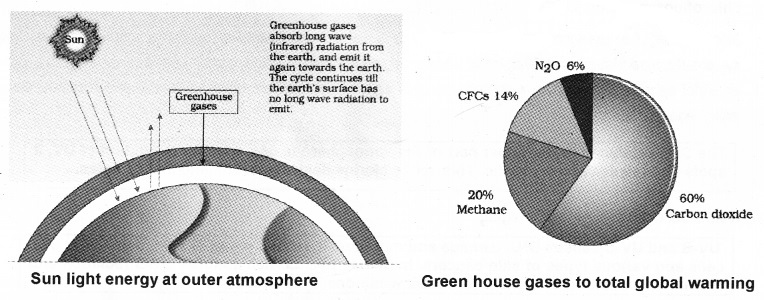
The incoming raditions of sunlight reaches the earth’s surface re-emits heat in the form of infrared radiation but part of this does not escape into space as atmospheric gases (e.g., carbon dioxide, methane, CFC and nitrogen oxides) absorb a major fraction of it.
The molecules of these gases radiate heat energy, and a major part of which again comes to Earth’s surface, thus heating it up once again This cycle is repeated many a times. This leading to global warming.
| During the past century, the temperature of Earth has increased by 0.6° C. This rise in temperature leads to the occurance of El Nino effect that is the melting of polar ice caps and Himalayan snow caps. It causes rise in sea level and submerge many coastal areas. |
To reduce the emission of green house gases it is necessary to
- Cutting down use of fossil fuel
- Improving efficiency of energy usage
- Reducing deforestation
- Planting trees and slowing down the growth of human population.
Ozone Depletion In The Stratosphere
There are two type of ozone that is ‘bad’ ozone, formed in the lower atmosphere (troposphere) that harms plants and animals. ‘Good’ ozone- this ozone is found in the upper part of the atmosphere (stratosphere), and it acts as a shield and absorbing ultraviolet radiation from the sun.
UV rays are harmful to living organisms since DNA and proteins of living organisms absorb it, and breaks the high energy chemical bonds within these molecules.
The thickness of the ozone in a column of air from the ground to the top of the atmosphere is measured in terms of Dobson units (DU).
Ozone hole in antartica area It is measured by Dobson unit:
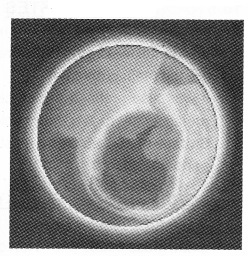
Ozone gas is continuously formed by the action of UV rays on molecular oxygen, and also degraded into molecular oxygen in the stratosphere.
The balance between production and degradation of ozone in the stratosphere is disrupted due to
chlorofluorocarbons (CFCs).
| The CFC produced in the upper part of the atmosphere is degraded by the action of UV. It splits and release active clorine. This active clorine destroys ozone and makes holes. |
It was first noticed in Antarctic region.
| UV-B and UV-C causes DNA damage and mutation. It causes aging of skin, damage to skin cells and various types of skin cancers. In human eye, cornea absorbs UV-B radiation and causes inflammation of cornea, called snow-blindness, cataract, etc. |
To reduce the emission of CFCs and other ozone depleting chemicals, an international treaty was formed known as the Montreal Protocol, signed at Montreal (Canada) in 1987.
Degradation By Improper Resource Utilisation And Maintenance
The important improper resource utilisation practices are
(1) Soil erosion and desertification:
The fertility of top-soil is lost due to over-cultivation, unrestricted grazing, deforestation and poor irrigation practices, resulting in arid patches of land. It result in the creation of desert.
(2) Waterlogging and soil salinity:
Irrigation without proper drainage of water leads to waterlogging in the soil. It also causes the deposition of salts on the land surface or starts collecting at the roots of the plants. This increased salt content and reduce the growth of crops and damaging to agriculture.
Deforestation
| At the beginning of the twentieth century, forests covered about 30 per cent of the land of India. By the end of the century, it shrunk to 19.4 per cent, whereas the National Forest Policy (1988) of India has recommended 33 per cent forest cover for the plains and 67 per cent for the hills. |
Deforestation occurs due to growing human population for timber, firewood, and several other purposes. Slash and burn agriculture, commonly called as Jhum cultivation in the north-eastern states of India, has also contributed to deforestation.
The ash is used as a fertiliser and the land is then used for farming or cattle grazing. The farmers then move on to other areas and repeat this process.
The consequences of deforestation are
- Increased carbon dioxide concentration in the atmosphere
- Loss of biodiversity due to habitat destruction
- Disturbs hydrologic cycle
- Causes soil erosion, and lead to desertification
Reforestation is the process of restoring a forest that once existed but was removed.
1. Case Study of People’s Participation in Conservation of Forests:
In 1731, the king of Jodhpur in Rajasthan asked one of his ministers to arrange wood for constructing a new palace. The minister and workers went to a forest near a village, inhabited by Bishnois, to cut down trees. Bishnois are opposed the act of ministers. Of which Amrita Devi-.her three daughters and hundreds of other Bishnois followed her, and thus lost their lives saving trees.
| The Government of India has recently established the Amrita Devi Bishnoi Wildlife Protection Award for individuals or communities from rural areas that have shown extraordinary courage and dedication in protecting wildlife. |
Another movement started at Garhwal Himalaya in 1974 was – Chipko Movement, here local women showed enormous bravery in protecting trees from the axe of contractors.
In 1980s Government of India has introduced the concept of Joint Forest Management (JFM) this is helpful to local communities for getting benefit of various forest products (e.g., fruits, gum, rubber, medicine, etc.) and thus the forest can be conserved in a sustainable manner.
We hope the Plus Two Botany Notes Chapter 8 Environmental Issues help you. If you have any query regarding Plus Two Botany Notes Chapter 8 Environmental Issues, drop a comment below and we will get back to you at the earliest.
